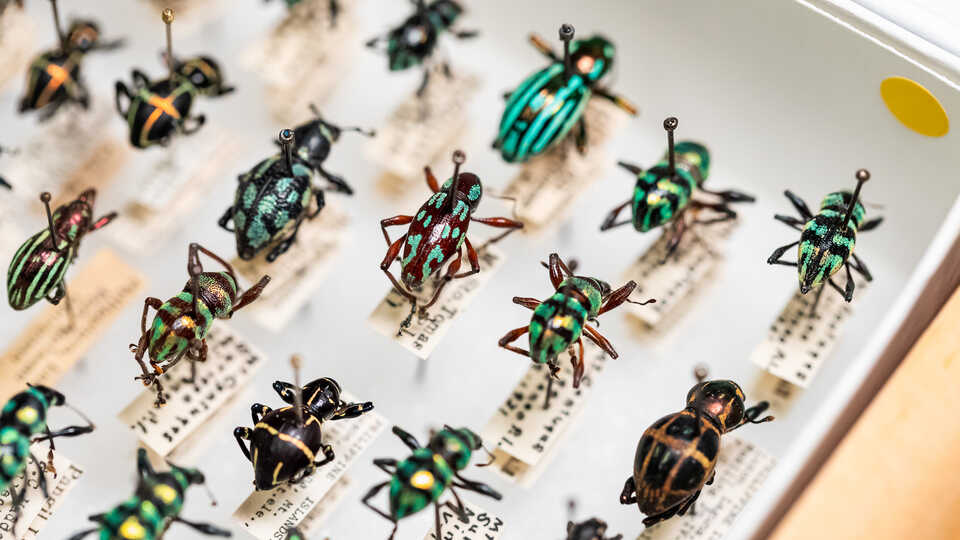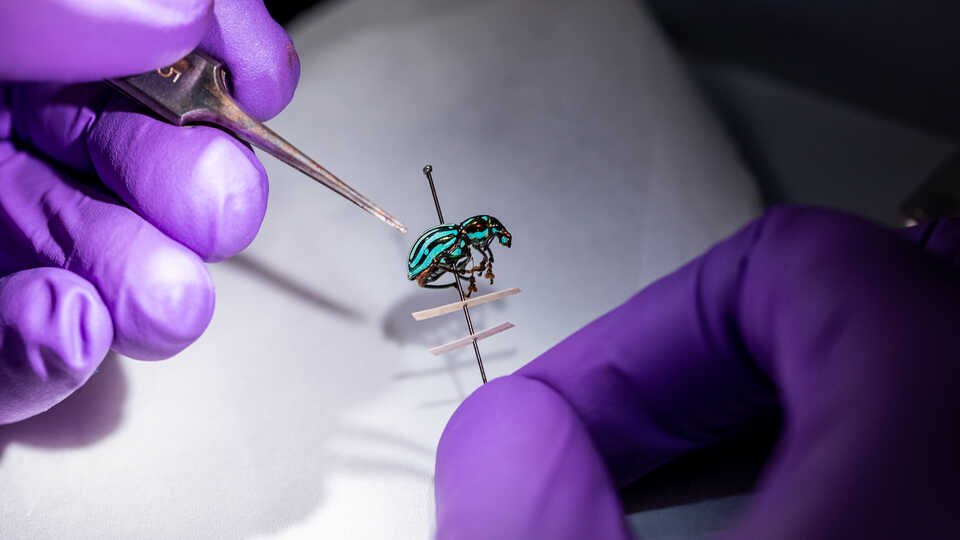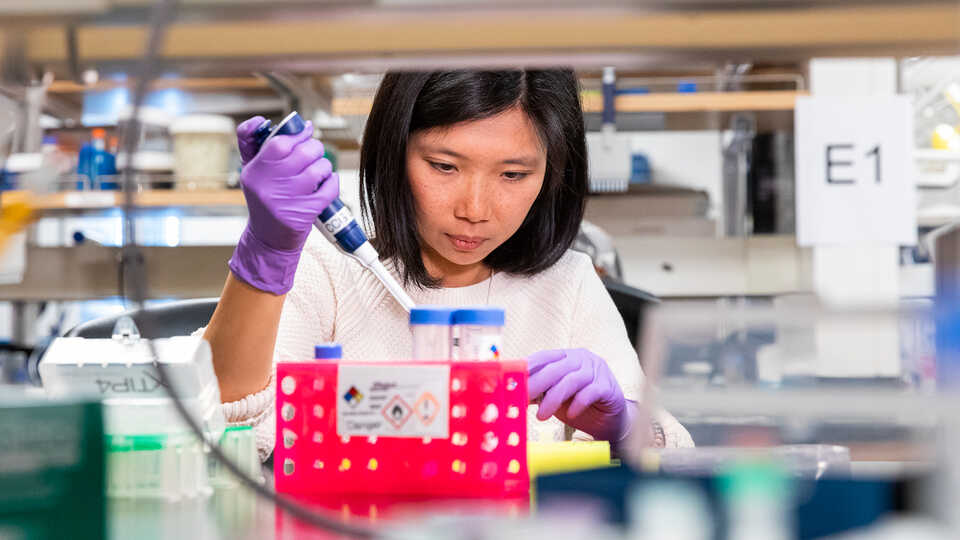The California Academy of Sciences is a renowned scientific and educational institution with a mission to regenerate the natural world through science, learning, and collaboration. Based in San Francisco’s Golden Gate Park, it is home to a world-class aquarium, planetarium, and natural history museum, as well as innovative programs in scientific research and environmental education—all under one living roof. Museum hours are 9:30 am – 5:00 pm Monday – Saturday, and 11:00 am – 5:00 pm on Sunday. Admission includes all exhibits, programs, and shows. For daily ticket prices, please visit www.calacademy.org or call (415) 379-8000 for more information.
Using cutting-edge sequencing technology, researchers determined the evolutionary origins of mimicry in the charismatic beetles
SAN FRANCISCO, CA (October 24, 2022) — Though the iridescent colors and intricate patterns of Easter egg weevils (Pachyrhynchus spp.) have captivated naturalists for centuries, their evolutionary history has remained largely misunderstood. Until now, species within the Pachyrhynchus genus have been lumped together based on similarities between their varied and distinct color patterns—a suspected result of a common ancestor. In a recently published study, however, researchers at the California Academy of Sciences and the University of Mindanao have discovered that these eye-catching patterns of reds, blues, greens, and golds developed through convergent evolution, or the independent evolution of similar characteristics across multiple unrelated species. This research was conducted through the Center for Comparative Genomics (CCG), the Academy’s in-house lab that serves as its core genomics and DNA sequencing center, and is part of the Academy’s Islands 2030 initiative to halt island biodiversity loss and habitat degradation.
Easter egg weevils are flightless beetles native to the oceanic islands of Southeast Asia, with their highest concentration of biodiversity in the Philippine archipelago. While they are found in a wide variety of ecosystems—from coastal forests to cloud forests at elevations up to 3,200 feet (1,000 meters)—their flightlessness restricts populations to their immediate environment. In places where multiple Pachyrhynchus species are present, they evolve to mimic each other.
“We found that the uniform color patterns between different Easter egg weevil species are a result of mimicry rather than a shared evolutionary history,” says study co-author and Academy researcher Matthew Van Dam, PhD. “When multiple species are present in the same environment, they evolve similar coloration and patterns that, to a predator, send the same message: stay away.”
This type of mimicry, known as Müllerian mimicry, occurs when multiple unpalatable species evolve to share similar external characteristics to deter predators. And though these weevils do not secrete any toxins, their hard exoskeletons are nearly impenetrable to predators (and are even known to break or bend the pins scientists use to collect them.)
To better understand the evolutionary origins of mimicry in the Pachyrhynchus genus, researchers analyzed and compared the complete genomes of pinned specimens housed in the Academy’s scientific collections as well as newly collected individuals from recent field work in the Philippines. By examining genetic markers within the weevils’ DNA, they were able to determine the relationships—or lack thereof—between species.
“We can’t sort these weevils into distinct species based on their physical appearance alone,” says study co-author and University of Mindanao researcher Analyn Cabras, PhD. “Two separate species may display identical color patterns, whereas two individuals of the same species may present entirely different coloration.”
While many insects get their warning hues from various pigments—which tend to fade over time—Easter egg weevils have structural coloration, or colorful scales embedded in their cuticles. These brightly colored patterns are made up of layers of tiny, angled discs that reflect light in different directions. “Because the orientation changes from scale to scale, you get this glittery effect that’s just like an opal,” Van Dam says. Thanks to this well-preserved structure, the researchers were able to sequence and compare weevils collected on various expeditions from the past 30 years.
For CCG Director Athena Lam, PhD, this research highlights the power of museum specimens in biodiversity research. “Not only are the Easter egg weevils a charismatic group, but they are ideal subjects for a genomics study,” Lam says. “Because of their striking colors, researchers have been collecting specimens for decades. This is just one example of the Academy’s unique ability to perform cutting-edge genomics research supported by a wealth of collected specimens.”
This research will empower conservationists to better protect these weevils by preserving their true genetic diversity rather than basing efforts around misleading similarities in color patterns. By leveraging the CCG, the research team hopes this study will provide a framework for a more comprehensive approach to future taxonomic studies—particularly those of threatened island ecosystems.
The Institute for Biodiversity Science and Sustainability at the California Academy of Sciences is at the forefront of efforts to regenerate the natural world through science, learning, and collaboration. Based in San Francisco, the Institute is home to more than 100 world-class scientists, state-of-the-art facilities, and nearly 46 million scientific specimens from around the world. The Institute also leverages the expertise and efforts of more than 100 international Associates and 450 distinguished Fellows. Through expeditions around the globe, investigations in the lab, and analysis of vast biological datasets, the Institute’s scientists work to understand the evolution and interconnectedness of organisms and ecosystems, the threats they face around the world, and the most effective strategies for ensuring they thrive into the future. Through deeply collaborative partnerships and innovative public engagement initiatives, they also guide critical conservation decisions worldwide, inspire and mentor the next generation of scientists, and foster responsible stewardship of our planet.
Press Contacts
If you are a journalist and would like to receive Academy press releases please contact press@calacademy.org.
Digital Assets
Hi-res and low-res image downloads are available for editorial use. Contact us at press@calacademy.org to request access.




